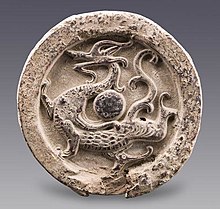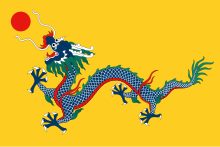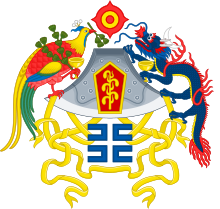

| Azure Dragon | |||||||||||||||||
|---|---|---|---|---|---|---|---|---|---|---|---|---|---|---|---|---|---|

Qīnglóng sculpture on the eaves tile
| |||||||||||||||||
| Chinese name | |||||||||||||||||
| Traditional Chinese | 青龍 | ||||||||||||||||
| Simplified Chinese | 青龙 | ||||||||||||||||
| Literal meaning | Blue-green Dragon | ||||||||||||||||
| |||||||||||||||||
| Vietnamese name | |||||||||||||||||
| Vietnamese alphabet | Thanh Long | ||||||||||||||||
| Chữ Hán | 青龍 | ||||||||||||||||
| Korean name | |||||||||||||||||
| Hangul | 청룡 | ||||||||||||||||
| Hanja | 靑龍 | ||||||||||||||||
| |||||||||||||||||
| Japanese name | |||||||||||||||||
| Kanji | 青竜 | ||||||||||||||||
| Hiragana | せいりゅう | ||||||||||||||||
| |||||||||||||||||



The Azure Dragon (Chinese: 青龍 Qīnglóng), also known as Qinglong in Chinese, is one of the Dragon Gods who represent the mount or chthonic forces of the Five Regions' Highest Deities (五方上帝 Wǔfāng Shàngdì). It is also one of the Four Symbols of the Chinese constellations, which are the astral representations of the Wufang Shangdi. The Azure Dragon represents the east and the spring season.[1] It is also sometimes referred to as the Blue-green Dragon, Green Dragon, or the Blue Dragon (蒼龍 Cānglóng).
The Dragon is frequently referred to in the media, feng shui, other cultures, and in various venues as the Green Dragon and the Avalon Dragon.[2] His cardinal direction's epithet is "Bluegreen Dragon of the East" (東方青龍 Dōngfāng Qīnglóngor東方蒼龍 Dōngfāng Cānglóng).
This dragon is also known as Seiryū in Japanese, Cheongryong in Korean and Thanh Long in Vietnamese.
As with the other three Symbols, there are seven astrological "Mansions" (positions of the Moon) within the Azure Dragon. The names and determinative stars are:[3][4]
| Mansion no. | Name (pinyin) | Translation | Determinative star |
|---|---|---|---|
| 1 | 角 (Jiăo) | Horn | Spica |
| 2 | 亢 (Kàng) | Neck | κ Vir |
| 3 | 氐 (Dĭ) | Root | α Lib |
| 4 | 房 (Fáng) | Room | π Sco |
| 5 | 心 (Xīn) | Heart | Antares |
| 6 | 尾 (Wěi) | Tail | μ Sco |
| 7 | 箕 (Jī) | Winnowing Basket | γ Sgr |

In the Romance of the Tales of the Tang [zh], the White Tiger's star is reincarnated as fictionalized General Luo Cheng, who serves Li Shimin. The Azure Dragon's Star is reincarnated as General Shan Xiongxin, who serves Wang Shichong. The two generals are sworn brothers of Qin Shubao, Cheng Zhijie and Yuchi Gong. After death, their souls are said to possess heroes of the Tang dynasty and Goguryeo, such as Xue Rengui and Yeon Gaesomun.
The Azure Dragon appears as a door god at Taoist temples. He was represented on the tomb of Wang Hui (stone coffin, east side) at Xikang in Lushan. A rubbing of this was collected by David Crockett Graham and is in the Field Museum of Natural History.[5][6] The dragon featured on the Chinese national flag in 1862–1912, and on the Twelve Symbols national emblem from 1913 to 1928.

In Japan, the Azure Dragon is one of the four guardian spirits of cities and is believed to protect the city of Kyoto on the east.[7] The west is protected by the White Tiger, the north is protected by the Black Tortoise, the south is protected by the Vermilion Bird, and the center is protected by the Yellow Dragon.[7] In Kyoto, there are temples dedicated to each of these guardian spirits. The Azure Dragon is represented in the Kiyomizu Temple in eastern Kyoto. Before the entrance of the temple there is a statue of the dragon, which is said to drink from the waterfall within the temple complex at nighttime. Therefore, each year a ceremony is held to worship the dragon of the east. In 1983, the Kitora Tomb was found in the village of Asuka. All four guardians were painted on the walls (in the corresponding directions) and a system of the constellations was painted on the ceiling. This is one of the few ancient records of the four guardians.
In Korea, the murals of the Goguryeo tombs found at Uhyon-ni in South Pyongan province features the Azure Dragon and the other mythological creatures of the four symbols.[2]
|
| |
|---|---|
| Overview topics |
|
| Major personages |
|
| Mythological creatures |
|
| Places |
|
| Items |
|
| Literary works |
|
| Other folk tales |
|
|
| |||||||||||
|---|---|---|---|---|---|---|---|---|---|---|---|
| Three Enclosures (三垣) |
| ||||||||||
| Four Symbols (四象) and Twenty-Eight Mansions (二十八宿) |
| ||||||||||